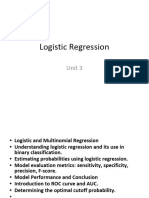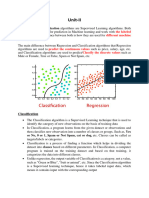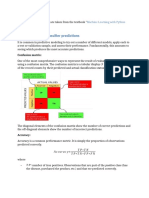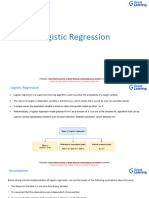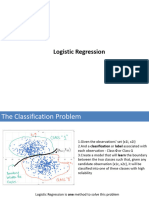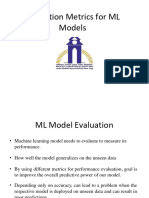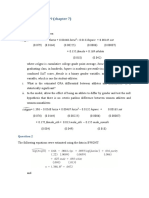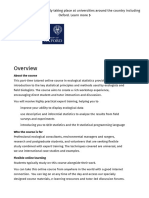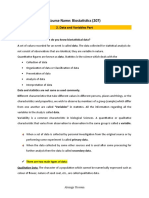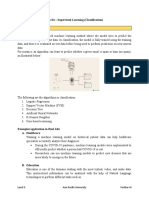Session-11 Machine Learning
Uploaded by
shrikantrathod9663Session-11 Machine Learning
Uploaded by
shrikantrathod96632/2/24, 7:29 PM Session-11 Machine Learning - Jupyter Notebook
Introduction
In linear regression, the type of data we deal with is quantitative, whereas we use
classification models to deal with qualitative data or categorical data. The algorithms used
for solving a classification problem first predict the probability of each of the categories of
the qualitative variables, as the basis for making the classification. And, as the probabilities
are continuous numbers, classification using probabilities also behave like regression
methods. Logistic regression is one such type of classification model which is used to
classify the dependent variable into two or more classes or categories.
Why don’t we use Linear regression for classification problems?
Let’s suppose you took a survey and noted the response of each person as satisfied, neutral
or Not satisfied. Let’s map each category:
Satisfied – 2
Neutral – 1
Not Satisfied – 0
But this doesn’t mean that the gap between Not satisfied and Neutral is same as Neutral
and satisfied. There is no mathematical significance of these mapping. We can also map the
categories like:
Satisfied – 0
Neutral – 1
Not Satisfied – 2
It’s completely fine to choose the above mapping. If we apply linear regression to both the
type of mappings, we will get different sets of predictions. Also, we can get prediction values
like 1.2, 0.8, 2.3 etc. which makes no sense for categorical values. So, there is no normal
method to convert qualitative data into quantitative data for use in linear regression.
Although, for binary classification, i.e. when there only two categorical values, using the
least square method can give decent results. Suppose we have two categories Black and
White and we map them as follows:
Black – 0
White - 1
We can assign predicted values for both the categories such as Y> 0.5 goes to class white
and vice versa. Although, there will be some predictions for which the value can be greater
than 1 or less than 0 making them hard to classify in any class. Nevertheless, linear
regression can work decently for binary classification but not that well for multi-class
classification. Hence, we use classification methods for dealing with such problems.
localhost:8888/notebooks/Downloads/Session-11 Machine Learning.ipynb 1/27
2/2/24, 7:29 PM Session-11 Machine Learning - Jupyter Notebook
Logistic Regression
Logistic regression is one such regression algorithm which can be used for performing
classification problems. It calculates the probability that a given value belongs to a specific
class. If the probability is more than 50%, it assigns the value in that particular class else if
the probability is less than 50%, the value is assigned to the other class. Therefore, we can
say that logistic regression acts as a binary classifier.
Working of a Logistic Model
For linear regression, the model is defined by: 𝑦 = 𝛽0 + 𝛽1 𝑥 - (i)
and for logistic regression, we calculate probability, i.e. y is the probability of a given variable
x belonging to a certain class. Thus, it is obvious that the value of y should lie between 0
and 1.
But, when we use equation(i) to calculate probability, we would get values less than 0 as
well as greater than 1. That doesn’t make any sense . So, we need to use such an equation
which always gives values between 0 and 1, as we desire while calculating the probability.
Sigmoid function
We use the sigmoid function as the underlying function in Logistic regression.
Mathematically and graphically.
Why do we use the Sigmoid Function?
1. The sigmoid function’s range is bounded between 0 and 1. Thus it’s useful in calculating
the probability for the Logistic function.
2. It’s derivative is easy to calculate than other functions which is useful during gradient
descent calculation.
3. It is a simple way of introducing non-linearity to the model.
Although there are other functions as well, which can be used, but sigmoid is the most
common function used for logistic regression. We will talk about the rest of the functions in
the neural network section.
Evaluation of a Classification Model
In machine learning, once we have a result of the classification problem, how do we
measure how accurate our classification is? For a regression problem, we have different
metrics like R Squared score, Mean Squared Error etc. what are the metrics to measure the
credibility of a classification model?
Metrics In a regression problem, the accuracy is generally measured in terms of the
difference in the actual values and the predicted values. In a classification problem, the
credibility of the model is measured using the confusion matrix generated, i.e., how
accurately the true positives and true negatives were predicted. The different metrics used
for this purpose are:
Accuracy
Recall
localhost:8888/notebooks/Downloads/Session-11 Machine Learning.ipynb 2/27
2/2/24, 7:29 PM Session-11 Machine Learning - Jupyter Notebook
Precision
F1 Score
Specifity
AUC( Area Under the Curve)
ROC(Receiver Operator Characteristic)
Classification Report
Confusion Matrix
Where the terms have the meaning:
True Positive(TP): A result that was predicted as positive by the classification model and
also is positive
True Negative(TN): A result that was predicted as negative by the classification model
and also is negative
False Positive(FP): A result that was predicted as positive by the classification model but
actually is negative
False Negative(FN): A result that was predicted as negative by the classification model
but actually is positive.
The Credibility of the model is based on how many correct predictions did the model do.
Accuracy
The mathematical formula is :
(𝑇𝑃+𝑇𝑁)
Accuracy= (𝑇𝑃+𝑇𝑁+𝐹𝑃+𝐹𝑁)
Or, it can be said that it’s defined as the total number of correct classifications divided by the
total number of classifications. Its is not the correct for inbalanc data beacause its always
show you high accurancy becoz its bais to the high count data in binary classification becoz
its not calculate the error / its won't count the error
Recall or Sensitivity
The mathematical formula is:
𝑇𝑃
Recall= (𝑇𝑃+𝐹𝑁)
Or, as the name suggests, it is a measure of: from the total number of positive results how
many positives were correctly predicted by the model.
It shows how relevant the model is, in terms of positive results only.
Consider a classification model , the model gave 50 correct predictions(TP) but failed to
identify 200 cancer patients(FN). Recall in that case will be:
50
Recall= (50+200) = 0.2 (The model was able to recall only 20% of the cancer patients)
localhost:8888/notebooks/Downloads/Session-11 Machine Learning.ipynb 3/27
2/2/24, 7:29 PM Session-11 Machine Learning - Jupyter Notebook
Precision
Precision is a measure of amongst all the positive predictions, how many of them were
actually positive. Mathematically,
𝑇𝑃
Precision= (𝑇𝑃+𝐹𝑃)
Let’s suppose in the previous example, the model identified 50 people as cancer
patients(TP) but also raised a false alarm for 100 patients(FP). Hence,
50
Precision= (50+100) =0.33 (The model only has a precision of 33%)
But we have a problem!!
As evident from the previous example, the model had a very high Accuracy but performed
poorly in terms of Precision and Recall. So, necessarily Accuracy is not the metric to use for
evaluating the model in this case.
Imagine a scenario, where the requirement was that the model recalled all the defaulters
who did not pay back the loan. Suppose there were 10 such defaulters and to recall those
10 defaulters, and the model gave you 20 results out of which only the 10 are the actual
defaulters. Now, the recall of the model is 100%, but the precision goes down to 50%.
F1 Score
From the previous examples, it is clear that we need a metric that considers both Precision
and Recall for evaluating a model. One such metric is the F1 score.
F1 score is defined as the harmonic mean of Precision and Recall.
2∗((𝑃𝑟𝑒𝑐𝑖𝑠𝑖𝑜𝑛∗𝑅𝑒𝑐𝑎𝑙𝑙)
The mathematical formula is: F1 score= (𝑃𝑟𝑒𝑐𝑖𝑠𝑖𝑜𝑛+𝑅𝑒𝑐𝑎𝑙𝑙))
Specificity or True Negative Rate
This represents how specific is the model while predicting the True Negatives.
Mathematically,
𝑇𝑁
Specificity= (𝑇𝑁+𝐹𝑃) Or, it can be said that it quantifies the total number of negatives
predicted by the model with respect to the total number of actual negative or non favorable
outcomes.
𝐹𝑃
Similarly, False Positive rate can be defined as: (1- specificity) Or, (𝑇𝑁+𝐹𝑃)
ROC(Receiver Operator Characteristic)
We know that the classification algorithms work on the concept of probability of occurrence
of the possible outcomes. A probability value lies between 0 and 1. Zero means that there is
no probability of occurrence and one means that the occurrence is certain.
But while working with real-time data, it has been observed that we seldom get a perfect 0
or 1 value. Instead of that, we get different decimal values lying between 0 and 1. Now the
question is if we are not getting binary probability values how are we actually determining
the class in our classification problem?
localhost:8888/notebooks/Downloads/Session-11 Machine Learning.ipynb 4/27
2/2/24, 7:29 PM Session-11 Machine Learning - Jupyter Notebook
There comes the concept of Threshold. A threshold is set, any probability value below the
threshold is a negative outcome, and anything more than the threshold is a favourable or the
positive outcome. For Example, if the threshold is 0.5, any probability value below 0.5
means a negative or an unfavourable outcome and any value above 0.5 indicates a positive
or favourable outcome.
Now, the question is, what should be an ideal threshold?
The horizontal lines represent the various values of thresholds ranging from 0 to 1.
Let’s suppose our classification problem was to identify the obese people from the
given data.
The green markers represent obese people and the red markers represent the non-
obese people.
Our confusion matrix will depend on the value of the threshold chosen by us.
For Example, if 0.25 is the threshold then TP(actually obese)=3 TN(Not obese)=2
FP(Not obese but predicted obese)=2(the two red squares above the 0.25 line)
FN(Obese but predicted as not obese )=1(Green circle below 0.25line )
business case: to predict weather a a patient
will have a diaabetes or not
In [78]: # libraries
import pandas as pd
import numpy as np
import seaborn as sns
import matplotlib.pyplot as plt
%matplotlib inline
In [5]: data = pd.read_csv('diabetes.csv')
In [6]: data
Out[6]:
Pregnancies Glucose BloodPressure SkinThickness Insulin BMI DiabetesPedigreeFun
0 6 148 72 35 0 33.6
1 1 85 66 29 0 26.6
2 8 183 64 0 0 23.3
3 1 89 66 23 94 28.1
4 0 137 40 35 168 43.1
... ... ... ... ... ... ...
763 10 101 76 48 180 32.9
764 2 122 70 27 0 36.8
765 5 121 72 23 112 26.2
766 1 126 60 0 0 30.1
767 1 93 70 31 0 30.4
768 rows × 9 columns
localhost:8888/notebooks/Downloads/Session-11 Machine Learning.ipynb 5/27
2/2/24, 7:29 PM Session-11 Machine Learning - Jupyter Notebook
In [7]: data.info()
<class 'pandas.core.frame.DataFrame'>
RangeIndex: 768 entries, 0 to 767
Data columns (total 9 columns):
# Column Non-Null Count Dtype
--- ------ -------------- -----
0 Pregnancies 768 non-null int64
1 Glucose 768 non-null int64
2 BloodPressure 768 non-null int64
3 SkinThickness 768 non-null int64
4 Insulin 768 non-null int64
5 BMI 768 non-null float64
6 DiabetesPedigreeFunction 768 non-null float64
7 Age 768 non-null int64
8 Outcome 768 non-null int64
dtypes: float64(2), int64(7)
memory usage: 54.1 KB
In [10]: data.describe()
Out[10]:
Pregnancies Glucose BloodPressure SkinThickness Insulin BMI Diab
count 768.000000 768.000000 768.000000 768.000000 768.000000 768.000000
mean 3.845052 120.894531 69.105469 20.536458 79.799479 31.992578
std 3.369578 31.972618 19.355807 15.952218 115.244002 7.884160
min 0.000000 0.000000 0.000000 0.000000 0.000000 0.000000
25% 1.000000 99.000000 62.000000 0.000000 0.000000 27.300000
50% 3.000000 117.000000 72.000000 23.000000 30.500000 32.000000
75% 6.000000 140.250000 80.000000 32.000000 127.250000 36.600000
max 17.000000 199.000000 122.000000 99.000000 846.000000 67.100000
EDA
In [12]: # Univariate analysis
localhost:8888/notebooks/Downloads/Session-11 Machine Learning.ipynb 6/27
2/2/24, 7:29 PM Session-11 Machine Learning - Jupyter Notebook
In [13]: !pip install sweetviz
Requirement already satisfied: sweetviz in c:\users\shrik\anaconda3\lib\si
te-packages (2.3.0)
Requirement already satisfied: pandas!=1.0.0,!=1.0.1,!=1.0.2,>=0.25.3 in
c:\users\shrik\anaconda3\lib\site-packages (from sweetviz) (2.0.3)
Requirement already satisfied: numpy>=1.16.0 in c:\users\shrik\anaconda3\l
ib\site-packages (from sweetviz) (1.24.3)
Requirement already satisfied: matplotlib>=3.1.3 in c:\users\shrik\anacond
a3\lib\site-packages (from sweetviz) (3.7.2)
Requirement already satisfied: tqdm>=4.43.0 in c:\users\shrik\anaconda3\li
b\site-packages (from sweetviz) (4.65.0)
Requirement already satisfied: scipy>=1.3.2 in c:\users\shrik\anaconda3\li
b\site-packages (from sweetviz) (1.11.1)
Requirement already satisfied: jinja2>=2.11.1 in c:\users\shrik\anaconda3
\lib\site-packages (from sweetviz) (3.1.2)
Requirement already satisfied: importlib-resources>=1.2.0 in c:\users\shri
k\anaconda3\lib\site-packages (from sweetviz) (6.1.1)
Requirement already satisfied: MarkupSafe>=2.0 in c:\users\shrik\anaconda3
\lib\site-packages (from jinja2>=2.11.1->sweetviz) (2.1.1)
Requirement already satisfied: contourpy>=1.0.1 in c:\users\shrik\anaconda
3\lib\site-packages (from matplotlib>=3.1.3->sweetviz) (1.0.5)
Requirement already satisfied: cycler>=0.10 in c:\users\shrik\anaconda3\li
b\site-packages (from matplotlib>=3.1.3->sweetviz) (0.11.0)
Requirement already satisfied: fonttools>=4.22.0 in c:\users\shrik\anacond
a3\lib\site-packages (from matplotlib>=3.1.3->sweetviz) (4.25.0)
Requirement already satisfied: kiwisolver>=1.0.1 in c:\users\shrik\anacond
a3\lib\site-packages (from matplotlib>=3.1.3->sweetviz) (1.4.4)
Requirement already satisfied: packaging>=20.0 in c:\users\shrik\anaconda3
\lib\site-packages (from matplotlib>=3.1.3->sweetviz) (23.1)
Requirement already satisfied: pillow>=6.2.0 in c:\users\shrik\anaconda3\l
ib\site-packages (from matplotlib>=3.1.3->sweetviz) (9.4.0)
Requirement already satisfied: pyparsing<3.1,>=2.3.1 in c:\users\shrik\ana
conda3\lib\site-packages (from matplotlib>=3.1.3->sweetviz) (3.0.9)
Requirement already satisfied: python-dateutil>=2.7 in c:\users\shrik\anac
onda3\lib\site-packages (from matplotlib>=3.1.3->sweetviz) (2.8.2)
Requirement already satisfied: pytz>=2020.1 in c:\users\shrik\anaconda3\li
b\site-packages (from pandas!=1.0.0,!=1.0.1,!=1.0.2,>=0.25.3->sweetviz) (2
023.3.post1)
Requirement already satisfied: tzdata>=2022.1 in c:\users\shrik\anaconda3
\lib\site-packages (from pandas!=1.0.0,!=1.0.1,!=1.0.2,>=0.25.3->sweetviz)
(2023.3)
Requirement already satisfied: colorama in c:\users\shrik\anaconda3\lib\si
te-packages (from tqdm>=4.43.0->sweetviz) (0.4.6)
Requirement already satisfied: six>=1.5 in c:\users\shrik\anaconda3\lib\si
te-packages (from python-dateutil>=2.7->matplotlib>=3.1.3->sweetviz) (1.1
6.0)
In [14]: import sweetviz as sv
my_report = sv.analyze(data)
my_report.show_html()
Done! Use 'show' commands to display/save. [100%] 00:01 -> (00:00 left)
Report SWEETVIZ_REPORT.html was generated! NOTEBOOK/COLAB USERS: the web b
rowser MAY not pop up, regardless, the report IS saved in your notebook/co
lab files.
localhost:8888/notebooks/Downloads/Session-11 Machine Learning.ipynb 7/27
2/2/24, 7:29 PM Session-11 Machine Learning - Jupyter Notebook
In [15]: data.head()
Out[15]:
Pregnancies Glucose BloodPressure SkinThickness Insulin BMI DiabetesPedigreeFunct
0 6 148 72 35 0 33.6 0.6
1 1 85 66 29 0 26.6 0.3
2 8 183 64 0 0 23.3 0.6
3 1 89 66 23 94 28.1 0.
4 0 137 40 35 168 43.1 2.2
In [16]: # bi variate analysis
In [17]: sns.countplot(x= data.Pregnancies, hue = data.Outcome)
plt.show()
In [18]: # missing values
localhost:8888/notebooks/Downloads/Session-11 Machine Learning.ipynb 8/27
2/2/24, 7:29 PM Session-11 Machine Learning - Jupyter Notebook
In [19]: data.isnull().sum()
Out[19]: Pregnancies 0
Glucose 0
BloodPressure 0
SkinThickness 0
Insulin 0
BMI 0
DiabetesPedigreeFunction 0
Age 0
Outcome 0
dtype: int64
In [20]: data.loc[data['BMI']==0]
Out[20]:
Pregnancies Glucose BloodPressure SkinThickness Insulin BMI DiabetesPedigreeFun
9 8 125 96 0 0 0.0
49 7 105 0 0 0 0.0
60 2 84 0 0 0 0.0
81 2 74 0 0 0 0.0
145 0 102 75 23 0 0.0
371 0 118 64 23 89 0.0
426 0 94 0 0 0 0.0
494 3 80 0 0 0 0.0
522 6 114 0 0 0 0.0
684 5 136 82 0 0 0.0
706 10 115 0 0 0 0.0
In [21]: data['BMI'].mean()
Out[21]: 31.992578124999998
In [22]: # replacing 0 values with either mean or meadian
data['BMI'] = data['BMI'].replace(0, data['BMI'].mean())
data['Glucose'] = data['Glucose'].replace(0, data['Glucose'].mean())
data['BloodPressure'] = data['BloodPressure'].replace(0, data['BloodPressure
data['SkinThickness'] = data['SkinThickness'].replace(0, data['SkinThickness
data['Insulin'] = data['Insulin'].replace(0, data['Insulin'].mean())
localhost:8888/notebooks/Downloads/Session-11 Machine Learning.ipynb 9/27
2/2/24, 7:29 PM Session-11 Machine Learning - Jupyter Notebook
In [23]: data.describe()
Out[23]:
Pregnancies Glucose BloodPressure SkinThickness Insulin BMI Diab
count 768.000000 768.000000 768.000000 768.000000 768.000000 768.000000
mean 3.845052 121.681605 72.254807 26.606479 118.660163 32.450805
std 3.369578 30.436016 12.115932 9.631241 93.080358 6.875374
min 0.000000 44.000000 24.000000 7.000000 14.000000 18.200000
25% 1.000000 99.750000 64.000000 20.536458 79.799479 27.500000
50% 3.000000 117.000000 72.000000 23.000000 79.799479 32.000000
75% 6.000000 140.250000 80.000000 32.000000 127.250000 36.600000
max 17.000000 199.000000 122.000000 99.000000 846.000000 67.100000
In [24]: data
Out[24]:
Pregnancies Glucose BloodPressure SkinThickness Insulin BMI DiabetesPedigree
0 6 148.0 72.0 35.000000 79.799479 33.6
1 1 85.0 66.0 29.000000 79.799479 26.6
2 8 183.0 64.0 20.536458 79.799479 23.3
3 1 89.0 66.0 23.000000 94.000000 28.1
4 0 137.0 40.0 35.000000 168.000000 43.1
... ... ... ... ... ... ...
763 10 101.0 76.0 48.000000 180.000000 32.9
764 2 122.0 70.0 27.000000 79.799479 36.8
765 5 121.0 72.0 23.000000 112.000000 26.2
766 1 126.0 60.0 20.536458 79.799479 30.1
767 1 93.0 70.0 31.000000 79.799479 30.4
768 rows × 9 columns
outliers
In [30]: data.columns
data1 = ['Pregnancies', 'Glucose', 'BloodPressure', 'SkinThickness', 'Insuli
'BMI', 'DiabetesPedigreeFunction', 'Age', 'Outcome']
localhost:8888/notebooks/Downloads/Session-11 Machine Learning.ipynb 10/27
2/2/24, 7:29 PM Session-11 Machine Learning - Jupyter Notebook
In [32]: plt.figure(figsize=(20,25), facecolor= 'White')
plotnumber =1
for column in data:
if plotnumber <= 9:
ax = plt.subplot(3,3, plotnumber)
sns.boxplot(data[column])
plt.xlabel(column, fontsize = 20)
plotnumber +=1
plt.show()
feature selection
localhost:8888/notebooks/Downloads/Session-11 Machine Learning.ipynb 11/27
2/2/24, 7:29 PM Session-11 Machine Learning - Jupyter Notebook
In [39]: tc = data.drop('Outcome', axis =1)
sns.heatmap(tc.corr(), annot = True)
plt.show()
In [40]: # Model Creation
localhost:8888/notebooks/Downloads/Session-11 Machine Learning.ipynb 12/27
2/2/24, 7:29 PM Session-11 Machine Learning - Jupyter Notebook
In [41]: data
Out[41]:
Pregnancies Glucose BloodPressure SkinThickness Insulin BMI DiabetesPedigree
0 6 148.0 72.0 35.000000 79.799479 33.6
1 1 85.0 66.0 29.000000 79.799479 26.6
2 8 183.0 64.0 20.536458 79.799479 23.3
3 1 89.0 66.0 23.000000 94.000000 28.1
4 0 137.0 40.0 35.000000 168.000000 43.1
... ... ... ... ... ... ...
763 10 101.0 76.0 48.000000 180.000000 32.9
764 2 122.0 70.0 27.000000 79.799479 36.8
765 5 121.0 72.0 23.000000 112.000000 26.2
766 1 126.0 60.0 20.536458 79.799479 30.1
767 1 93.0 70.0 31.000000 79.799479 30.4
768 rows × 9 columns
In [42]: X = data.drop('Outcome', axis=1)
y = data['Outcome']
In [43]: X
Out[43]:
Pregnancies Glucose BloodPressure SkinThickness Insulin BMI DiabetesPedigree
0 6 148.0 72.0 35.000000 79.799479 33.6
1 1 85.0 66.0 29.000000 79.799479 26.6
2 8 183.0 64.0 20.536458 79.799479 23.3
3 1 89.0 66.0 23.000000 94.000000 28.1
4 0 137.0 40.0 35.000000 168.000000 43.1
... ... ... ... ... ... ...
763 10 101.0 76.0 48.000000 180.000000 32.9
764 2 122.0 70.0 27.000000 79.799479 36.8
765 5 121.0 72.0 23.000000 112.000000 26.2
766 1 126.0 60.0 20.536458 79.799479 30.1
767 1 93.0 70.0 31.000000 79.799479 30.4
768 rows × 8 columns
localhost:8888/notebooks/Downloads/Session-11 Machine Learning.ipynb 13/27
2/2/24, 7:29 PM Session-11 Machine Learning - Jupyter Notebook
In [44]: # scale the individual features
# 1. min-max scaler
# 2. standard scaler
In [45]: from sklearn.preprocessing import StandardScaler
scaler = StandardScaler()
X_scaled = scaler.fit_transform(X)
In [46]: X_scaled
Out[46]: array([[ 0.63994726, 0.86527574, -0.0210444 , ..., 0.16725546,
0.46849198, 1.4259954 ],
[-0.84488505, -1.20598931, -0.51658286, ..., -0.85153454,
-0.36506078, -0.19067191],
[ 1.23388019, 2.01597855, -0.68176235, ..., -1.33182125,
0.60439732, -0.10558415],
...,
[ 0.3429808 , -0.02240928, -0.0210444 , ..., -0.90975111,
-0.68519336, -0.27575966],
[-0.84488505, 0.14197684, -1.01212132, ..., -0.34213954,
-0.37110101, 1.17073215],
[-0.84488505, -0.94297153, -0.18622389, ..., -0.29847711,
-0.47378505, -0.87137393]])
In [47]: from sklearn.model_selection import train_test_split
X_train, x_test, y_train, y_test = train_test_split(X_scaled, y, test_size=0
In [48]: from sklearn.linear_model import LogisticRegression
log_reg = LogisticRegression()
log_reg.fit(X_train, y_train)
Out[48]: ▾ LogisticRegression
LogisticRegression()
In [50]: y_train_pred = log_reg.predict(X_train)
localhost:8888/notebooks/Downloads/Session-11 Machine Learning.ipynb 14/27
2/2/24, 7:29 PM Session-11 Machine Learning - Jupyter Notebook
In [51]: y_train_pred
Out[51]: array([1, 1, 0, 1, 0, 1, 0, 1, 0, 0, 0, 0, 1, 0, 0, 1, 0, 0, 0, 1, 0, 1,
0, 0, 0, 0, 0, 1, 0, 0, 1, 1, 0, 0, 1, 1, 1, 0, 0, 0, 0, 0, 0, 1,
0, 0, 0, 1, 0, 0, 0, 0, 0, 0, 0, 1, 0, 0, 0, 0, 0, 0, 1, 0, 0, 0,
0, 1, 1, 0, 0, 1, 0, 0, 0, 0, 1, 0, 0, 0, 1, 0, 0, 0, 0, 1, 0, 0,
0, 1, 0, 1, 0, 1, 0, 1, 0, 0, 1, 0, 0, 0, 0, 1, 0, 1, 0, 1, 0, 0,
0, 1, 0, 1, 0, 0, 0, 1, 1, 0, 0, 1, 0, 1, 0, 1, 0, 0, 1, 0, 0, 0,
0, 0, 0, 0, 0, 0, 0, 0, 0, 0, 0, 0, 1, 0, 0, 1, 0, 0, 0, 1, 0, 0,
0, 0, 1, 0, 1, 1, 0, 0, 0, 0, 0, 0, 0, 1, 0, 0, 0, 0, 0, 0, 0, 0,
0, 1, 0, 0, 0, 0, 0, 1, 0, 0, 0, 0, 0, 1, 0, 0, 1, 0, 0, 0, 1, 0,
0, 0, 0, 0, 0, 0, 0, 0, 0, 0, 1, 0, 0, 0, 0, 1, 0, 1, 0, 0, 1, 0,
1, 0, 0, 0, 0, 0, 0, 0, 0, 0, 1, 0, 0, 0, 0, 0, 0, 1, 0, 0, 0, 0,
0, 0, 0, 0, 0, 0, 0, 0, 0, 0, 0, 0, 0, 1, 0, 1, 0, 0, 1, 1, 1, 1,
0, 0, 0, 0, 0, 0, 0, 1, 0, 1, 1, 0, 1, 1, 1, 0, 0, 0, 0, 0, 0, 1,
0, 1, 0, 1, 0, 1, 0, 0, 0, 0, 0, 1, 1, 0, 0, 1, 1, 0, 0, 0, 1, 0,
1, 0, 0, 0, 0, 1, 1, 0, 0, 0, 0, 0, 1, 0, 0, 1, 0, 1, 1, 0, 0, 0,
0, 0, 0, 0, 0, 0, 0, 0, 0, 0, 0, 0, 0, 0, 0, 0, 0, 1, 0, 0, 1, 1,
1, 0, 0, 0, 1, 1, 0, 1, 0, 1, 0, 0, 0, 0, 1, 1, 0, 0, 0, 0, 0, 0,
0, 0, 0, 0, 0, 0, 0, 0, 0, 0, 0, 0, 0, 0, 0, 1, 0, 0, 0, 0, 1, 0,
1, 0, 1, 1, 1, 0, 1, 1, 1, 0, 1, 0, 1, 1, 0, 0, 0, 1, 0, 1, 0, 0,
0, 0, 0, 1, 0, 0, 0, 0, 1, 0, 1, 0, 0, 0, 1, 0, 1, 0, 1, 0, 0, 0,
0, 1, 0, 0, 0, 0, 0, 0, 0, 0, 0, 1, 1, 0, 0, 0, 0, 0, 1, 1, 1, 0,
0, 0, 1, 0, 0, 0, 1, 0, 0, 0, 0, 0, 0, 1, 0, 0, 0, 0, 0, 1, 1, 1,
0, 0, 1, 1, 0, 0, 0, 1, 0, 1, 0, 1, 0, 0, 0, 0, 1, 1, 0, 0, 0, 0,
0, 1, 0, 0, 0, 0, 0, 0, 1, 0, 0, 1, 1, 0, 0, 0, 0, 0, 1, 1, 0, 1,
0, 1, 0, 0, 0, 1, 1, 1, 0, 0, 0, 1, 0, 0, 0, 0, 0, 0, 0, 0, 0, 0,
1, 0, 0, 0, 1, 0, 0, 0, 0, 1, 0, 1, 0, 0, 0, 1, 0, 1, 1, 0, 0, 0,
1, 0, 0, 0], dtype=int64)
In [52]: y_pred = log_reg.predict(x_test)
In [53]: y_pred
Out[53]: array([0, 0, 0, 0, 0, 0, 1, 0, 1, 1, 1, 0, 1, 0, 0, 1, 0, 0, 0, 1, 0, 0,
0, 0, 0, 1, 0, 0, 0, 0, 1, 0, 1, 0, 0, 1, 0, 0, 0, 0, 0, 0, 1, 1,
0, 1, 0, 0, 1, 0, 0, 1, 1, 0, 0, 0, 0, 0, 0, 0, 0, 1, 1, 0, 0, 0,
0, 0, 1, 0, 1, 1, 1, 0, 0, 0, 0, 1, 0, 0, 0, 0, 0, 0, 1, 0, 0, 0,
0, 1, 0, 0, 0, 0, 1, 0, 0, 0, 1, 0, 1, 0, 0, 1, 0, 0, 0, 0, 0, 0,
0, 0, 1, 1, 0, 1, 0, 0, 0, 0, 0, 0, 0, 0, 0, 0, 1, 0, 0, 0, 0, 0,
0, 0, 1, 0, 0, 0, 0, 0, 0, 0, 1, 0, 0, 0, 0, 0, 0, 0, 0, 0, 0, 1,
0, 0, 1, 0, 0, 0, 0, 0, 0, 0, 1, 0, 0, 0, 1, 0, 0, 1, 0, 0, 0, 1,
0, 1, 1, 0, 0, 0, 0, 0, 0, 1, 1, 1, 0, 0, 1, 0], dtype=int64)
In [55]: y_pred.shape
Out[55]: (192,)
localhost:8888/notebooks/Downloads/Session-11 Machine Learning.ipynb 15/27
2/2/24, 7:29 PM Session-11 Machine Learning - Jupyter Notebook
In [56]: data
Out[56]:
Pregnancies Glucose BloodPressure SkinThickness Insulin BMI DiabetesPedigree
0 6 148.0 72.0 35.000000 79.799479 33.6
1 1 85.0 66.0 29.000000 79.799479 26.6
2 8 183.0 64.0 20.536458 79.799479 23.3
3 1 89.0 66.0 23.000000 94.000000 28.1
4 0 137.0 40.0 35.000000 168.000000 43.1
... ... ... ... ... ... ...
763 10 101.0 76.0 48.000000 180.000000 32.9
764 2 122.0 70.0 27.000000 79.799479 36.8
765 5 121.0 72.0 23.000000 112.000000 26.2
766 1 126.0 60.0 20.536458 79.799479 30.1
767 1 93.0 70.0 31.000000 79.799479 30.4
768 rows × 9 columns
In [57]: # evaluating logistic regression model
In [77]: from sklearn.metrics import (accuracy_score, confusion_matrix, precision_sco
recall_score, f1_score, roc_auc_score, classification_report)
In [59]: accuracy = accuracy_score(y_test, y_pred)
accuracy
Out[59]: 0.78125
In [60]: precision = precision_score(y_test, y_pred)
In [61]: precision
Out[61]: 0.7708333333333334
In [63]: recall = recall_score(y_test, y_pred)
In [64]: recall
Out[64]: 0.5441176470588235
In [66]: f1_score= f1_score(y_test, y_pred)
In [67]: f1_score
Out[67]: 0.6379310344827587
localhost:8888/notebooks/Downloads/Session-11 Machine Learning.ipynb 16/27
2/2/24, 7:29 PM Session-11 Machine Learning - Jupyter Notebook
In [68]: pd.crosstab(y_test, y_pred)
Out[68]:
col_0 0 1
Outcome
0 113 11
1 31 37
In [70]: auc = roc_auc_score(y_test, y_pred)
In [71]: auc
Out[71]: 0.7277039848197343
In [73]: report = classification_report(y_test,y_pred)
In [75]: print(report)
precision recall f1-score support
0 0.78 0.91 0.84 124
1 0.77 0.54 0.64 68
accuracy 0.78 192
macro avg 0.78 0.73 0.74 192
weighted avg 0.78 0.78 0.77 192
Multiclass classification
In [80]: import pandas as pd
import seaborn as sns
In [81]: data = sns.load_dataset('iris')
localhost:8888/notebooks/Downloads/Session-11 Machine Learning.ipynb 17/27
2/2/24, 7:29 PM Session-11 Machine Learning - Jupyter Notebook
In [82]: data
Out[82]:
sepal_length sepal_width petal_length petal_width species
0 5.1 3.5 1.4 0.2 setosa
1 4.9 3.0 1.4 0.2 setosa
2 4.7 3.2 1.3 0.2 setosa
3 4.6 3.1 1.5 0.2 setosa
4 5.0 3.6 1.4 0.2 setosa
... ... ... ... ... ...
145 6.7 3.0 5.2 2.3 virginica
146 6.3 2.5 5.0 1.9 virginica
147 6.5 3.0 5.2 2.0 virginica
148 6.2 3.4 5.4 2.3 virginica
149 5.9 3.0 5.1 1.8 virginica
150 rows × 5 columns
In [84]: data.species.unique()
Out[84]: array(['setosa', 'versicolor', 'virginica'], dtype=object)
In [85]: data.species.value_counts()
Out[85]: species
setosa 50
versicolor 50
virginica 50
Name: count, dtype: int64
In [91]: X = data.loc[:,['sepal_length', 'sepal_width', 'petal_length', 'petal_width
y = data.species
localhost:8888/notebooks/Downloads/Session-11 Machine Learning.ipynb 18/27
2/2/24, 7:29 PM Session-11 Machine Learning - Jupyter Notebook
In [90]: X
Out[90]:
sepal_length sepal_width petal_length petal_width
0 5.1 3.5 1.4 0.2
1 4.9 3.0 1.4 0.2
2 4.7 3.2 1.3 0.2
3 4.6 3.1 1.5 0.2
4 5.0 3.6 1.4 0.2
... ... ... ... ...
145 6.7 3.0 5.2 2.3
146 6.3 2.5 5.0 1.9
147 6.5 3.0 5.2 2.0
148 6.2 3.4 5.4 2.3
149 5.9 3.0 5.1 1.8
150 rows × 4 columns
In [92]: y
Out[92]: 0 setosa
1 setosa
2 setosa
3 setosa
4 setosa
...
145 virginica
146 virginica
147 virginica
148 virginica
149 virginica
Name: species, Length: 150, dtype: object
In [93]: from sklearn.preprocessing import StandardScaler
sc = StandardScaler()
X_new = sc.fit_transform(X)
localhost:8888/notebooks/Downloads/Session-11 Machine Learning.ipynb 19/27
2/2/24, 7:29 PM Session-11 Machine Learning - Jupyter Notebook
In [94]: X_new
localhost:8888/notebooks/Downloads/Session-11 Machine Learning.ipynb 20/27
2/2/24, 7:29 PM Session-11 Machine Learning - Jupyter Notebook
Out[94]: array([[-9.00681170e-01, 1.01900435e+00, -1.34022653e+00,
-1.31544430e+00],
[-1.14301691e+00, -1.31979479e-01, -1.34022653e+00,
-1.31544430e+00],
[-1.38535265e+00, 3.28414053e-01, -1.39706395e+00,
-1.31544430e+00],
[-1.50652052e+00, 9.82172869e-02, -1.28338910e+00,
-1.31544430e+00],
[-1.02184904e+00, 1.24920112e+00, -1.34022653e+00,
-1.31544430e+00],
[-5.37177559e-01, 1.93979142e+00, -1.16971425e+00,
-1.05217993e+00],
[-1.50652052e+00, 7.88807586e-01, -1.34022653e+00,
-1.18381211e+00],
[-1.02184904e+00, 7.88807586e-01, -1.28338910e+00,
-1.31544430e+00],
[-1.74885626e+00, -3.62176246e-01, -1.34022653e+00,
-1.31544430e+00],
[-1.14301691e+00, 9.82172869e-02, -1.28338910e+00,
-1.44707648e+00],
[-5.37177559e-01, 1.47939788e+00, -1.28338910e+00,
-1.31544430e+00],
[-1.26418478e+00, 7.88807586e-01, -1.22655167e+00,
-1.31544430e+00],
[-1.26418478e+00, -1.31979479e-01, -1.34022653e+00,
-1.44707648e+00],
[-1.87002413e+00, -1.31979479e-01, -1.51073881e+00,
-1.44707648e+00],
[-5.25060772e-02, 2.16998818e+00, -1.45390138e+00,
-1.31544430e+00],
[-1.73673948e-01, 3.09077525e+00, -1.28338910e+00,
-1.05217993e+00],
[-5.37177559e-01, 1.93979142e+00, -1.39706395e+00,
-1.05217993e+00],
[-9.00681170e-01, 1.01900435e+00, -1.34022653e+00,
-1.18381211e+00],
[-1.73673948e-01, 1.70959465e+00, -1.16971425e+00,
-1.18381211e+00],
[-9.00681170e-01, 1.70959465e+00, -1.28338910e+00,
-1.18381211e+00],
[-5.37177559e-01, 7.88807586e-01, -1.16971425e+00,
-1.31544430e+00],
[-9.00681170e-01, 1.47939788e+00, -1.28338910e+00,
-1.05217993e+00],
[-1.50652052e+00, 1.24920112e+00, -1.56757623e+00,
-1.31544430e+00],
[-9.00681170e-01, 5.58610819e-01, -1.16971425e+00,
-9.20547742e-01],
[-1.26418478e+00, 7.88807586e-01, -1.05603939e+00,
-1.31544430e+00],
[-1.02184904e+00, -1.31979479e-01, -1.22655167e+00,
-1.31544430e+00],
[-1.02184904e+00, 7.88807586e-01, -1.22655167e+00,
-1.05217993e+00],
[-7.79513300e-01, 1.01900435e+00, -1.28338910e+00,
-1.31544430e+00],
[-7.79513300e-01, 7.88807586e-01, -1.34022653e+00,
-1.31544430e+00],
[-1.38535265e+00, 3.28414053e-01, -1.22655167e+00,
-1.31544430e+00],
[-1.26418478e+00, 9.82172869e-02, -1.22655167e+00,
localhost:8888/notebooks/Downloads/Session-11 Machine Learning.ipynb 21/27
2/2/24, 7:29 PM Session-11 Machine Learning - Jupyter Notebook
-1.31544430e+00],
[-5.37177559e-01, 7.88807586e-01, -1.28338910e+00,
-1.05217993e+00],
[-7.79513300e-01, 2.40018495e+00, -1.28338910e+00,
-1.44707648e+00],
[-4.16009689e-01, 2.63038172e+00, -1.34022653e+00,
-1.31544430e+00],
[-1.14301691e+00, 9.82172869e-02, -1.28338910e+00,
-1.31544430e+00],
[-1.02184904e+00, 3.28414053e-01, -1.45390138e+00,
-1.31544430e+00],
[-4.16009689e-01, 1.01900435e+00, -1.39706395e+00,
-1.31544430e+00],
[-1.14301691e+00, 1.24920112e+00, -1.34022653e+00,
-1.44707648e+00],
[-1.74885626e+00, -1.31979479e-01, -1.39706395e+00,
-1.31544430e+00],
[-9.00681170e-01, 7.88807586e-01, -1.28338910e+00,
-1.31544430e+00],
[-1.02184904e+00, 1.01900435e+00, -1.39706395e+00,
-1.18381211e+00],
[-1.62768839e+00, -1.74335684e+00, -1.39706395e+00,
-1.18381211e+00],
[-1.74885626e+00, 3.28414053e-01, -1.39706395e+00,
-1.31544430e+00],
[-1.02184904e+00, 1.01900435e+00, -1.22655167e+00,
-7.88915558e-01],
[-9.00681170e-01, 1.70959465e+00, -1.05603939e+00,
-1.05217993e+00],
[-1.26418478e+00, -1.31979479e-01, -1.34022653e+00,
-1.18381211e+00],
[-9.00681170e-01, 1.70959465e+00, -1.22655167e+00,
-1.31544430e+00],
[-1.50652052e+00, 3.28414053e-01, -1.34022653e+00,
-1.31544430e+00],
[-6.58345429e-01, 1.47939788e+00, -1.28338910e+00,
-1.31544430e+00],
[-1.02184904e+00, 5.58610819e-01, -1.34022653e+00,
-1.31544430e+00],
[ 1.40150837e+00, 3.28414053e-01, 5.35408562e-01,
2.64141916e-01],
[ 6.74501145e-01, 3.28414053e-01, 4.21733708e-01,
3.95774101e-01],
[ 1.28034050e+00, 9.82172869e-02, 6.49083415e-01,
3.95774101e-01],
[-4.16009689e-01, -1.74335684e+00, 1.37546573e-01,
1.32509732e-01],
[ 7.95669016e-01, -5.92373012e-01, 4.78571135e-01,
3.95774101e-01],
[-1.73673948e-01, -5.92373012e-01, 4.21733708e-01,
1.32509732e-01],
[ 5.53333275e-01, 5.58610819e-01, 5.35408562e-01,
5.27406285e-01],
[-1.14301691e+00, -1.51316008e+00, -2.60315415e-01,
-2.62386821e-01],
[ 9.16836886e-01, -3.62176246e-01, 4.78571135e-01,
1.32509732e-01],
[-7.79513300e-01, -8.22569778e-01, 8.07091462e-02,
2.64141916e-01],
[-1.02184904e+00, -2.43394714e+00, -1.46640561e-01,
-2.62386821e-01],
localhost:8888/notebooks/Downloads/Session-11 Machine Learning.ipynb 22/27
2/2/24, 7:29 PM Session-11 Machine Learning - Jupyter Notebook
[ 6.86617933e-02, -1.31979479e-01, 2.51221427e-01,
3.95774101e-01],
[ 1.89829664e-01, -1.97355361e+00, 1.37546573e-01,
-2.62386821e-01],
[ 3.10997534e-01, -3.62176246e-01, 5.35408562e-01,
2.64141916e-01],
[-2.94841818e-01, -3.62176246e-01, -8.98031345e-02,
1.32509732e-01],
[ 1.03800476e+00, 9.82172869e-02, 3.64896281e-01,
2.64141916e-01],
[-2.94841818e-01, -1.31979479e-01, 4.21733708e-01,
3.95774101e-01],
[-5.25060772e-02, -8.22569778e-01, 1.94384000e-01,
-2.62386821e-01],
[ 4.32165405e-01, -1.97355361e+00, 4.21733708e-01,
3.95774101e-01],
[-2.94841818e-01, -1.28296331e+00, 8.07091462e-02,
-1.30754636e-01],
[ 6.86617933e-02, 3.28414053e-01, 5.92245988e-01,
7.90670654e-01],
[ 3.10997534e-01, -5.92373012e-01, 1.37546573e-01,
1.32509732e-01],
[ 5.53333275e-01, -1.28296331e+00, 6.49083415e-01,
3.95774101e-01],
[ 3.10997534e-01, -5.92373012e-01, 5.35408562e-01,
8.77547895e-04],
[ 6.74501145e-01, -3.62176246e-01, 3.08058854e-01,
1.32509732e-01],
[ 9.16836886e-01, -1.31979479e-01, 3.64896281e-01,
2.64141916e-01],
[ 1.15917263e+00, -5.92373012e-01, 5.92245988e-01,
2.64141916e-01],
[ 1.03800476e+00, -1.31979479e-01, 7.05920842e-01,
6.59038469e-01],
[ 1.89829664e-01, -3.62176246e-01, 4.21733708e-01,
3.95774101e-01],
[-1.73673948e-01, -1.05276654e+00, -1.46640561e-01,
-2.62386821e-01],
[-4.16009689e-01, -1.51316008e+00, 2.38717193e-02,
-1.30754636e-01],
[-4.16009689e-01, -1.51316008e+00, -3.29657076e-02,
-2.62386821e-01],
[-5.25060772e-02, -8.22569778e-01, 8.07091462e-02,
8.77547895e-04],
[ 1.89829664e-01, -8.22569778e-01, 7.62758269e-01,
5.27406285e-01],
[-5.37177559e-01, -1.31979479e-01, 4.21733708e-01,
3.95774101e-01],
[ 1.89829664e-01, 7.88807586e-01, 4.21733708e-01,
5.27406285e-01],
[ 1.03800476e+00, 9.82172869e-02, 5.35408562e-01,
3.95774101e-01],
[ 5.53333275e-01, -1.74335684e+00, 3.64896281e-01,
1.32509732e-01],
[-2.94841818e-01, -1.31979479e-01, 1.94384000e-01,
1.32509732e-01],
[-4.16009689e-01, -1.28296331e+00, 1.37546573e-01,
1.32509732e-01],
[-4.16009689e-01, -1.05276654e+00, 3.64896281e-01,
8.77547895e-04],
[ 3.10997534e-01, -1.31979479e-01, 4.78571135e-01,
localhost:8888/notebooks/Downloads/Session-11 Machine Learning.ipynb 23/27
2/2/24, 7:29 PM Session-11 Machine Learning - Jupyter Notebook
2.64141916e-01],
[-5.25060772e-02, -1.05276654e+00, 1.37546573e-01,
8.77547895e-04],
[-1.02184904e+00, -1.74335684e+00, -2.60315415e-01,
-2.62386821e-01],
[-2.94841818e-01, -8.22569778e-01, 2.51221427e-01,
1.32509732e-01],
[-1.73673948e-01, -1.31979479e-01, 2.51221427e-01,
8.77547895e-04],
[-1.73673948e-01, -3.62176246e-01, 2.51221427e-01,
1.32509732e-01],
[ 4.32165405e-01, -3.62176246e-01, 3.08058854e-01,
1.32509732e-01],
[-9.00681170e-01, -1.28296331e+00, -4.30827696e-01,
-1.30754636e-01],
[-1.73673948e-01, -5.92373012e-01, 1.94384000e-01,
1.32509732e-01],
[ 5.53333275e-01, 5.58610819e-01, 1.27429511e+00,
1.71209594e+00],
[-5.25060772e-02, -8.22569778e-01, 7.62758269e-01,
9.22302838e-01],
[ 1.52267624e+00, -1.31979479e-01, 1.21745768e+00,
1.18556721e+00],
[ 5.53333275e-01, -3.62176246e-01, 1.04694540e+00,
7.90670654e-01],
[ 7.95669016e-01, -1.31979479e-01, 1.16062026e+00,
1.31719939e+00],
[ 2.12851559e+00, -1.31979479e-01, 1.61531967e+00,
1.18556721e+00],
[-1.14301691e+00, -1.28296331e+00, 4.21733708e-01,
6.59038469e-01],
[ 1.76501198e+00, -3.62176246e-01, 1.44480739e+00,
7.90670654e-01],
[ 1.03800476e+00, -1.28296331e+00, 1.16062026e+00,
7.90670654e-01],
[ 1.64384411e+00, 1.24920112e+00, 1.33113254e+00,
1.71209594e+00],
[ 7.95669016e-01, 3.28414053e-01, 7.62758269e-01,
1.05393502e+00],
[ 6.74501145e-01, -8.22569778e-01, 8.76433123e-01,
9.22302838e-01],
[ 1.15917263e+00, -1.31979479e-01, 9.90107977e-01,
1.18556721e+00],
[-1.73673948e-01, -1.28296331e+00, 7.05920842e-01,
1.05393502e+00],
[-5.25060772e-02, -5.92373012e-01, 7.62758269e-01,
1.58046376e+00],
[ 6.74501145e-01, 3.28414053e-01, 8.76433123e-01,
1.44883158e+00],
[ 7.95669016e-01, -1.31979479e-01, 9.90107977e-01,
7.90670654e-01],
[ 2.24968346e+00, 1.70959465e+00, 1.67215710e+00,
1.31719939e+00],
[ 2.24968346e+00, -1.05276654e+00, 1.78583195e+00,
1.44883158e+00],
[ 1.89829664e-01, -1.97355361e+00, 7.05920842e-01,
3.95774101e-01],
[ 1.28034050e+00, 3.28414053e-01, 1.10378283e+00,
1.44883158e+00],
[-2.94841818e-01, -5.92373012e-01, 6.49083415e-01,
1.05393502e+00],
localhost:8888/notebooks/Downloads/Session-11 Machine Learning.ipynb 24/27
2/2/24, 7:29 PM Session-11 Machine Learning - Jupyter Notebook
[ 2.24968346e+00, -5.92373012e-01, 1.67215710e+00,
1.05393502e+00],
[ 5.53333275e-01, -8.22569778e-01, 6.49083415e-01,
7.90670654e-01],
[ 1.03800476e+00, 5.58610819e-01, 1.10378283e+00,
1.18556721e+00],
[ 1.64384411e+00, 3.28414053e-01, 1.27429511e+00,
7.90670654e-01],
[ 4.32165405e-01, -5.92373012e-01, 5.92245988e-01,
7.90670654e-01],
[ 3.10997534e-01, -1.31979479e-01, 6.49083415e-01,
7.90670654e-01],
[ 6.74501145e-01, -5.92373012e-01, 1.04694540e+00,
1.18556721e+00],
[ 1.64384411e+00, -1.31979479e-01, 1.16062026e+00,
5.27406285e-01],
[ 1.88617985e+00, -5.92373012e-01, 1.33113254e+00,
9.22302838e-01],
[ 2.49201920e+00, 1.70959465e+00, 1.50164482e+00,
1.05393502e+00],
[ 6.74501145e-01, -5.92373012e-01, 1.04694540e+00,
1.31719939e+00],
[ 5.53333275e-01, -5.92373012e-01, 7.62758269e-01,
3.95774101e-01],
[ 3.10997534e-01, -1.05276654e+00, 1.04694540e+00,
2.64141916e-01],
[ 2.24968346e+00, -1.31979479e-01, 1.33113254e+00,
1.44883158e+00],
[ 5.53333275e-01, 7.88807586e-01, 1.04694540e+00,
1.58046376e+00],
[ 6.74501145e-01, 9.82172869e-02, 9.90107977e-01,
7.90670654e-01],
[ 1.89829664e-01, -1.31979479e-01, 5.92245988e-01,
7.90670654e-01],
[ 1.28034050e+00, 9.82172869e-02, 9.33270550e-01,
1.18556721e+00],
[ 1.03800476e+00, 9.82172869e-02, 1.04694540e+00,
1.58046376e+00],
[ 1.28034050e+00, 9.82172869e-02, 7.62758269e-01,
1.44883158e+00],
[-5.25060772e-02, -8.22569778e-01, 7.62758269e-01,
9.22302838e-01],
[ 1.15917263e+00, 3.28414053e-01, 1.21745768e+00,
1.44883158e+00],
[ 1.03800476e+00, 5.58610819e-01, 1.10378283e+00,
1.71209594e+00],
[ 1.03800476e+00, -1.31979479e-01, 8.19595696e-01,
1.44883158e+00],
[ 5.53333275e-01, -1.28296331e+00, 7.05920842e-01,
9.22302838e-01],
[ 7.95669016e-01, -1.31979479e-01, 8.19595696e-01,
1.05393502e+00],
[ 4.32165405e-01, 7.88807586e-01, 9.33270550e-01,
1.44883158e+00],
[ 6.86617933e-02, -1.31979479e-01, 7.62758269e-01,
7.90670654e-01]])
localhost:8888/notebooks/Downloads/Session-11 Machine Learning.ipynb 25/27
2/2/24, 7:29 PM Session-11 Machine Learning - Jupyter Notebook
In [102]: X_train, X_test, y_train, y_test = train_test_split(X_new, y, random_state=
In [103]: y_train
Out[103]: 4 setosa
32 setosa
142 virginica
85 versicolor
86 versicolor
...
71 versicolor
106 virginica
14 setosa
92 versicolor
102 virginica
Name: species, Length: 112, dtype: object
In [104]: from sklearn.linear_model import LogisticRegression
In [105]: LR = LogisticRegression(multi_class= 'ovr')
In [106]: LR.fit(X_train, y_train)
Out[106]: ▾ LogisticRegression
LogisticRegression(multi_class='ovr')
In [107]: y_hat = LR.predict(X_test)
In [108]: y_hat
Out[108]: array(['versicolor', 'setosa', 'virginica', 'versicolor', 'versicolor',
'setosa', 'versicolor', 'virginica', 'versicolor', 'versicolor',
'virginica', 'setosa', 'setosa', 'setosa', 'setosa', 'virginica',
'virginica', 'versicolor', 'versicolor', 'virginica', 'setosa',
'virginica', 'setosa', 'virginica', 'virginica', 'virginica',
'virginica', 'virginica', 'setosa', 'setosa', 'setosa', 'setosa',
'versicolor', 'setosa', 'setosa', 'virginica', 'versicolor',
'setosa'], dtype=object)
In [111]: # single parameter
new = [[0.5,0.5,0.5,0.5]]
In [112]: LR.predict(new)
Out[112]: array(['virginica'], dtype=object)
In [113]: X_test.shape
Out[113]: (38, 4)
localhost:8888/notebooks/Downloads/Session-11 Machine Learning.ipynb 26/27
2/2/24, 7:29 PM Session-11 Machine Learning - Jupyter Notebook
In [115]: pd.crosstab(y_test, y_hat)
Out[115]:
col_0 setosa versicolor virginica
species
setosa 15 0 0
versicolor 0 10 1
virginica 0 0 12
In [118]: recall = recall_score(y_test, y_hat, average= 'weighted')
recall
Out[118]: 0.9736842105263158
In [120]: precision = precision_score(y_test, y_hat, average = 'weighted')
precision
Out[120]: 0.9757085020242916
In [121]: print(classification_report(y_test, y_hat))
precision recall f1-score support
setosa 1.00 1.00 1.00 15
versicolor 1.00 0.91 0.95 11
virginica 0.92 1.00 0.96 12
accuracy 0.97 38
macro avg 0.97 0.97 0.97 38
weighted avg 0.98 0.97 0.97 38
For any queries:
# premierintellectruals@gmail.com
In [ ]:
localhost:8888/notebooks/Downloads/Session-11 Machine Learning.ipynb 27/27
You might also like
- Session-11 Machine Learning - Jupyter NotebookNo ratings yetSession-11 Machine Learning - Jupyter Notebook11 pages
- Evaluation Metrics in Machine Learning - GeeksforGeeksNo ratings yetEvaluation Metrics in Machine Learning - GeeksforGeeks6 pages
- ML CLASS 5 Logistic Regression AlgorithmNo ratings yetML CLASS 5 Logistic Regression Algorithm16 pages
- Intermediate Analytics-Regression-Week 3-1No ratings yetIntermediate Analytics-Regression-Week 3-144 pages
- Business Statistics For Contemporary Decision Making 7th Edition by Ken Black Ebook and TestBank Bundle Verified PDFNo ratings yetBusiness Statistics For Contemporary Decision Making 7th Edition by Ken Black Ebook and TestBank Bundle Verified PDF410 pages
- BP 801t Biostatistics and Research Methodology Jun 2020No ratings yetBP 801t Biostatistics and Research Methodology Jun 20203 pages
- 285 (Ebook PDF) Methods in Behavioural Research 2rd by Paul C. Cozby Download100% (3)285 (Ebook PDF) Methods in Behavioural Research 2rd by Paul C. Cozby Download55 pages
- Statistik 1 - 6 Distribusi Probabilitas NormalNo ratings yetStatistik 1 - 6 Distribusi Probabilitas Normal49 pages
- Lab 04 - Supervised ML Classification - UpdatedNo ratings yetLab 04 - Supervised ML Classification - Updated21 pages

